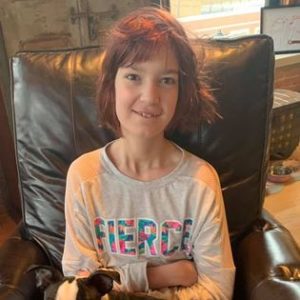Julia
 May 17th, 2001 was a day that changed my life forever. Julia Marie Novak was born at 6:20pm, weighing seven pounds and eleven ounces. I remember thinking to myself that seven and eleven were good luck numbers, sealing her fate of a perfect life.
May 17th, 2001 was a day that changed my life forever. Julia Marie Novak was born at 6:20pm, weighing seven pounds and eleven ounces. I remember thinking to myself that seven and eleven were good luck numbers, sealing her fate of a perfect life.
Eighteen months later on Christmas of 2002, my sister brought Julia a little cart to push around the house. Though Julia wasn’t really walking yet, she grabbed the cart. My sister and I encouraged Julia to walk across the carpet to our open hands. She would toddle across and then lunge into our arms for a big congratulatory hug. By the time Julia was two, she was walking. Her gait was wide and a little unsteady, but she was walking nonetheless.
When Julia was in PreK 3, the school’s social worker called me in for a meeting. After expressing concern about Julia’s development, she asked me if we had ever taken Julia to see a neurologist. I was taken aback. I knew little about specialized medicine and my only thought was that the social worker was suggesting there was something wrong with Julia’s brain. I was appalled, shocked and incensed—this woman barely knew my child and casually mentioned the need for something so intensely shocking. I left that meeting feeling as if I had been hit by a truck. It struck a nerve in me that I was not yet prepared to hear from the outside. Yes, I knew something was physically different about my daughter, but there was NO WAY she had any other issues. Couldn’t the social worker and the rest of school see her the way I did? Couldn’t they overlook the way she walked and just concentrate on how smart she was? I felt like running into the classroom and scooping Julia up in my arms, fleeing out of the school and never returning. But I also knew, way deep down in that depth of my heart that we needed answers and whatever was going on with my daughter was not going to just go away.
In July of 2005, an MRI revealed that Julia’s cerebellum did not form properly and the connective tissue in the middle of the cerebellum was not developed at all. We were given a diagnosis of Cerebral Palsy and were told her condition would not decline. At five years old, she had the gross motor skills of a 16-month-old baby. I was devastated.
We met with another neurologist who specializes in ataxia, which describes Julia’s gate. He decided Julia should have another MRI. When the results came back, there was mention of a possible demyelinating disease. I was so busy trying to get her to all her therapies and finding the right school that I paid little attention to the comments.
Several years later, her neurologist told me about a syndrome that had been discovered called 4H syndrome. Julia ticked some boxes, but not all of them. At that time, the only way to get a diagnosis was to do a whole gene exome, which was not covered by insurance.
Julia did not go through puberty, another symptom of 4H. By this time, Drs. Wolf and Van der knapp developed the ability to diagnose the disease via MRI. Julia’s neurologist sent the scans to Amsterdam for review.
On June 8th, 2013, our lives were changed forever. Julia’s neurologist sent an email explaining that Julia tested positive for 4H on the B mutation. When I began my research into 4H, one of the first things I read was a life expectancy of only 30 years. She was twelve at the time. Did she really only have another 18 years to live?
Julia has shown some signs of 4H. It takes her about 3 weeks to get over a common cold. Healing from an injury takes several months. But she has taught me patience and the importance of living in the moment. She is always happy and has a great sense of humor. I am blessed to be her mother.
The YaYa foundation has finally given us a voice to express the need for research. To date, there are no treatments or cures. The YaYa foundation is working tirelessly to raise money, awareness and to help families when they are at a complete loss of what this diagnosis means. We are a tight 4H family, our kids are genetically related, and we are determined to fight this horrible disease.
